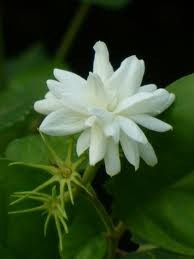Peacock jasmine, also known as the "Pikake" plant, is known primarily for the flowers it produces. These flowers are the traditional blooms that make up authentic Hawaiian leis, and gardeners wanting to bring a little bit of their vacation back home with them often choose the peacock jasmine plant to keep indoors. This plant can thrive indoors given the right care and treatment; these are easy to provide indoors, even in especially cold climates.
- When selecting a peacock jasmine plant to grow indoors, Top Tropicals (an international retailer of tropical plants) recommends selecting a smaller plant. Peacock jasmine can tolerate both full sun and partial shade very well, but in either case a sudden transition from one environment to the next can be particularly stressful for the plant. This being the case, it is easier to start with a younger plant (less than one year old) and guide it to maturity in your home’s conditions than taking an established plant and trying to make it work for you.
The unique versatility of the plant’s sun preferences gives you quite a bit of leeway when choosing a spot in the home, but if possible it will still be best to position your plant in a south facing window where the plant can access sunlight. While your plant can survive just about anywhere, it will bloom for a much longer period of time (in some cases these plants have bloomed all year long) if it has constant access to sunlight.
Soil/Fertilizer
- Kenneth Leonhardt and Glenn Teves of the Department of Tropical Plant and Soil Sciences at the University of Hawaii point out that peacock jasmine will grow best in a primarily organic, sandy or loamy soil. These types of soil have excellent drainage qualities, and they go on to state that, "Good drainage is essential because waterlogging kills almost all species of Jasminum."
As with any indoor plant, you can expect to fertilize peacock jasmine throughout the year. The good news is that this plant needs far less than many other species of plants grown indoors. "Fertilizer is applied when the plants are pruned during the winter months and two to three times during the rest of the year," Leonhardt and Teves state. Peacock jasmine won’t have a need for unusual fertilizers, so the best practice for a healthy plant is to perform soil tests every two or three months to determine what nutrients your plant needs.
Pruning
- Pruning your plant will be an easy task, and is only necessary once a year. Leonhardt and Teves suggest pruning between November and January, when the plant has a tendency to slow down or stop flower production. Unlike many plants, pruning peacock jasmine is done primarily for size control and flower production. Simply prune branches and stems back to a manageable size for the space and pot you have planted the flower in. Trim away dead or dying branches, and you’ll trigger new and vibrant growth in the plant. If you don’t mind a little more maintenance of your plant, you can also prune during peak flowering times (this will vary somewhat according to your locale, but is an easily recognizable phase). Doing so will cause more lateral branches to form, and in turn you’ll have even more flowers than would have otherwise been possible. This is not required, though, and can be skipped by any gardeners looking for a lower maintenance plant.
Constant Flowering
- Advanced gardeners may take on the challenge of encouraging flowering year round, and this has been successfully done by many. The plant will need constant sunlight and more regular fertilizer applications in order to support the ongoing demands of constant flower production, and you should still anticipate smaller and fewer flowers during the typical dormant phase. That said, many individuals want the year long scent of fresh jasmine flowers in the home and the peacock jasmine can certainly provide this benefit to those who are willing to work a little harder for it.


Deprecated: strpos(): Passing null to parameter #1 ($haystack) of type string is deprecated in /home/agriviek8Qv/agriviet.net/public_html/wp-includes/comment-template.php on line 2522